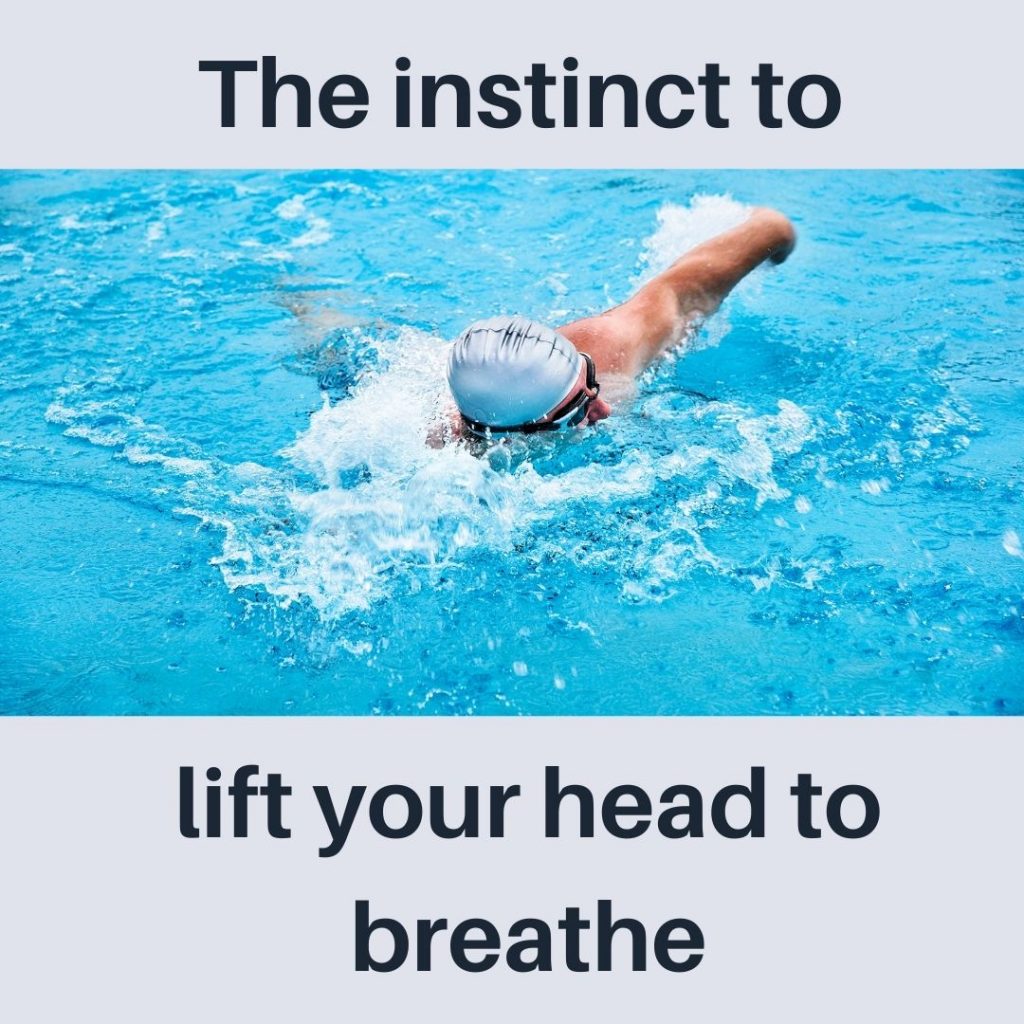A Universal problem
The biggest challenge we face as land mammas is that swimming efficiently is not hard wired in to our DNA, we are four limbed mammals, we have no gills or a blowhole. We are made for firm ground.
Breathing on land is an unconscious act, but to breathe seamlessly while swimming, like all of swimming is a skill, one that to needs to be learned.
As land mammals our survival instinct to swim reflects our four limbs and terrestrial body, we pull on our arms, kick our legs and lift our heads to breathe. These actions put our body out of balance, cause a loss of momentum and rhythm and waste energy from a body already challenged and stressed by a ‘leaky fuel tank’ fuelled with poor quality breathing.
A heavy breather can feel themselves sinking, an otherwise fit individual can be left exhausted as they lose control of their breathing, leaving them quite literally feeling puffed out.
Hold your breath for too long, blow out too much or feel your face is tight and lips clenched these acts will encourage a gasp in. This will take air to top part of your lungs, breathing here is similar to that experienced during anxiety or panic. Not the emotions you want to dial into while in water.
To swim with ease, efficiency and comfort, a relaxed diaphragmatic breath is the central building block for a calm, controlled and comfortable stroke and most importantly a calm, controlled and comfortable you. Putting you in an emotional state where you are capable of making good choices, feel calm and in control of your swim, rather than surviving or enduring your swim.

With a relaxed breath comes the mental calm to focus on technique improvements and efficiency gains. Without the breath your body and mind will stay in survival mode.
Swimming is a perfect form of moving mediation, where you are able to shift your consciousness while doing simple movements; calm, controlled rhythmical efficiency both in your breathing and technique will improve not only the buoyancy and efficiency in your swimming; it is the rhythmical shift of swimming postures and movements that will take you to the air. The closest we get to having gills.
During lessons breath management is addressed from the outset, non breathing exercises a vital part of the learning process where we can create change and build a balanced and stable non-breathing stroke. As your strokes and skills improves the breath fits into the rotational rhythm of your stroke, striving towards a seamless transition between breathing and non breathing strokes.
An advanced version of all skill is the accompaniment of a controlled and gentle exhale. An exhale that maintains buoyancy, that maintains a sense of calm, improves stamina and endurance.
All skill is improvable. Nothing is set. Anything is possible.
The list below is a glimpse of how the swimmers I meet describe their biggest challenges when swimming.
The answers below are a response to the question
“Describe your biggest challenge when faced with swimming”
The answers follow a theme.
Swimming is a universal human problem, a problem to be solved and you may recognise yourself within the examples.
Swimming continually without getting exhausted after just a few lengths. I can only swim continuously by alternating lengths of crawl and breast-stroke
Correct breathing technique and efficiency
Stamina to keep going long distance
Boredom on long-distance swims, not sure my stroke is very good!
I think it has to be finding a rhythm in breathing
I treat swimming like I would biking or running in the respect that in order to go faster I try harder. It’s a hard concept to reverse
Front-crawl kick and relaxed breathing
Confidence in front crawl, especially with breathing
Frustration while everyone seems to be faster and on occasion still struggling with getting in to a breathing rhythm
Lack of coordination, leading to frustration and lack of confidence
Efficiency and pace
Organising my breathing during crawl
Poor core stability, (abdominal surgery 3y ago), maintaining breathing at pace
Self belief
Getting into routine with breathing
I feel although I swim regularly and up to 2 miles some days, I find that although I’m consistent I don’t feel to be very fast, I’ve tried changing technique but find that others with terrible technique swim faster than me
Generating propulsion from my legs; frustration with not being able to identify what I’m doing wrong; slow progression
Breathing. So far my main technique is to just hold my breath for a length, so switch to breast stroke, or stop swimming
Trying to be calm and philosophical about having to use crowded lanes in English council pools, where swimming can sometimes feel like being on a busy motorway
Stamina, correcting bad habits, feeling relaxed and changing pace
Balance and ease of breathing
Timing and breathing
Confidence
Swimming crawl without exhausting myself
I want to be able to swim at a much faster pace
Relaxing slowing down and not trying to muscle it!
When I try to swim continuously, I get super winded and exhausted
Pushing myself past the fatigue. Sometimes get an annoying stitch type pain around right hand rib cage area
Due to it being so long since I learnt to swim and having swum only breast stroke for so long I have no real understanding of the technique for front crawl. I therefore struggle with the breathing and cannot get into a rhythm. This means I struggle to swim more than 1-2 lengths of front crawl at a time
Find doing front crawl for even medium time periods to be exhausting
I need to exert a lot of energy and focus to swim front crawl. I struggle to maintain an easy rhythm of strokes and breathing. Instead of being able to focus on how my body feels I am constantly adjusting my stroke and rhythm to keep moving
Maintaining speed and stamina
